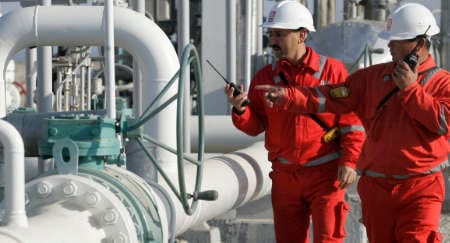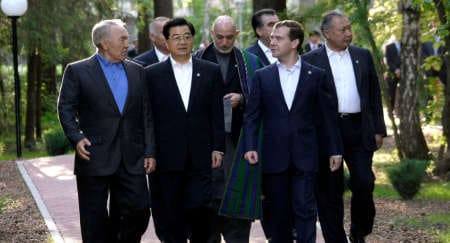Despite larger or more volatile Asian countries often dominating headlines, there is now an growing interest in Central Asian countries' increasingly important resources, location and allegiances. Regional expert, Dr Tamara Makarenko, shares her opinions on how this interest has played out.
Having been involved with Central Asia since 1998 on both an academic and professional level, I have concluded that the region provides exhaustive case studies of how relations between international interests, the legitimate economy, criminality and political violence collide and/or converge.
This view originally resulted from my academic research on the crime-terror nexus – deducing in 2000 that the Islamic Movement of Uzbekistan gained momentum because Juma Namanganiy was able to weave (the façade of) legitimate business dealings with narcotics trafficking.
Examples evolved into more sophisticated operations over the years as business, criminal and political interests increasingly converged. For example, evidence in Kyrgyzstan suggests that although key economic sectors are often intertwined with illegal activities, they are given carte blanche access to the banking system and attract foreign investment.

In an increasingly energy hungry world, Central Asia's resources are attracting growing interest © Reuters/Sergei Karpukhin
Instead of adopting Western espoused and supported democratic ideals and market mechanisms as the a priori ways through which economic growth and political stability could be achieved, Central Asia has found its development constrained by the power amassed by authoritarian regimes, oligarchs, and criminal networks.
Furthermore, despite regularly admonishing the region for their lack of democratic progress or their inability to establish control over criminality and rising extremism, the actions of external actors perpetuate autocratic rule and corruption, which subsequently feeds into a climate of economic, political and social instability.
Central Asia is part of several struggles that intermittently see external actors compete for attention and ultimately for access to resources
Geo-economics as the New Geopolitics
Historically, Central Asia has been referred to in the context of its position at the crossroads of East and West, nestled between empires and bordering zones of conflict and insecurity (e.g. Afghanistan, China’s Xinjiang province, and Iran). Although the region was largely ignored throughout the Cold War, its vitality and importance was quickly rediscovered.
Central Asia is continuously recognised as an important stakeholder in the Caspian energy game, a conduit to Chinese energy security, a playground of Russian power politics, and a transit area for criminal activity and religious fervour that is played out to its extreme in Afghanistan.
Given these regional realities, Central Asia is part of several struggles that intermittently see external actors compete for attention and ultimately for access to resources. The competition for control over regional resources is often exemplified in bilateral and multilateral economic and military agreements that are negotiated with the Central Asian states.
Although there is no illusion that external states are in a position to dictate terms of engagement, regional elites have recognised that they can leverage competing interests to their (often personal) advantage. As a result, concepts such as the rule of law, corporate governance, and transparency in commercial operations are often considered to be expendable in the national interest.
Plays of power politics are no longer isolated to state actions alone, but incorporate the ability of states to use commercial interests and circumvent criminal control over economic spheres without creating greater short-term instability. Isolating the activities of China, Russia and the U.S., it may be argued that – in doing so - each of these states have helped sustain the status quo of the Central Asian republics. Access to resources and infrastructure have become prioritised as soft power tools through which they perceive to be able to incrementally increase their regional influence.
China’s Extended Africa Strategy
Involved in the region since the 1990s, the Chinese strategy in Central Asia is undoubtedly multifaceted. A key driver of China’s policy in the region, however, appears to be mirroring its Africa policy. In other words, China is steadily increasing its regional presence through the acquisition of stakes in energy and infrastructure assets, and by providing “no-strings attached” loans. For example, Beijing recently agreed to provide Astana with a U.S. $10 billion loan to be used exclusively for the development of the oil and gas industry: a move likely to be used to expand its energy links in the region.
Although several bilateral agreements have been finalised between Beijing and Dushanbe, Tashkent, Almaty and Bishkek respectively and Beijing has attained a balanced position with Russia in the Shanghai Cooperation Organisation, its strongest foothold has been gained through a carefully targeted investment strategy. This is evident in Tajikistan, with Chinese participation in the aluminium industry and in Kazakhstan, with key commercial agreements signed with KazMunaiGaz and Kazatomprom. Europe has begun to note with concern China’s investment patterns, with Chinese foreign direct investment and long-term loans equalling an estimated U.S. $13 billion in the region.

Leaders of countries in the Shanghai Cooperation Organisation (SCO) at a SCO meeting © Reuters/POOL New
Russia’s Oligarch Power Plays
Russia has also successfully managed to use the commercial sphere to consolidate its influence and power in Central Asia. This has been especially evident in Kazakhstan – arguably Russia’s only direct link to the other republics. Russia has made its initial inroads in the Kazakh banking system through state-owned banks – both through the direct and indirect acquisition of shares. In theory, this policy will allow Moscow to exert influence on the Kazakh economy by controlling access to loans, and decisions on commercial debt. Vnesheconombank, for example, gave Astana a U.S. $3.5 billion loan to be used solely to purchase Russian products. It is also likely that Kazakh BTA Bank will follow a restructuring path that involves a possible sale to Russia’s Sberbank.
Despite a focus on cornering the financial market, Russia is also gaining influence in the energy and mining sectors. Companies including Polyus Gold and Polymetal have gained considerable leverage over gold and copper deposits; and LUKoil continues to expand its presence. For example, Moscow offered capital at a time of crisis to ensure that LUKoil could purchase BP’s stake in the Caspian Pipeline Consortium project. It is also worth noting that LUKoil was invited to sit on Kazakhstan’s Foreign Investments Council in 2003 by President Nursultan Nazarbayev.
Both China and Russia, in following commercial strategies to gain influence in the region, have inadvertently contributed to securing the current political status quo. Investigating various business deals that have included Chinese or Russian interests has confirmed that in many instances the rule of law, corporate governance, and transparency of beneficial ownership are considered to be luxuries and thus dispensable. State involvement in commercial transactions thus has little to do with contributing to the creation of sustainable economic growth. In fact, several commercial transactions have merely worked to sustain the ‘shadow state’, ensuring that income generation is not tied to economic development but to securing regime survival.
U.S. Focus on Security Priorities
Unlike China and Russia whose engagement with Central Asia has not been constrained or driven by security considerations, much of U.S. involvement in the region post-9/11 has been focused on securing and managing military base agreements. It is in these commercial agreements that the U.S. has mirrored the actions of China and Russia – circumventing market mechanisms cherished in the West to secure its own national priorities.
The example of Manas base in Kyrgyzstan is a well-documented case in point. In 2005 the FBI initiated an investigation that uncovered the embezzlement of millions of dollars from fuel contracts the Pentagon awarded to companies controlled by the then-President’s son and son-in-law. This trend merely continued after Bakiev replaced Akayev, with lucrative fuel contracts now going to companies allegedly controlled by the current President’s son. Not only did the U.S. pay a high financial price to secure access (commercial agreements combined with increased aid), but some also accused Washington of turning a blind eye to the many reported anomalies associated with the last Kyrgyz presidential elections.
The heightened importance of Central Asia in the post-9/11 environment has created an altered reality
Geo-economic Power Plays & Central Asian Security
Security in Central Asia has most readily fallen under the rubric of geopolitics, territorially used as a stage upon which external actors could engage in games of power politics. The heightened importance of the region in the post-9/11 environment has created an altered reality; however one in which the fundamental games have not changed, merely the ways in which they are played. Although the immediate impact of this slight twist in context is not obvious, there is a danger that in building an economic house of cards, Central Asia will be in a position to affect regional instability more directly.
The emergence of legitimate business interests and investment opportunities will undoubtedly continue to contribute to some form of widespread economic stability, as it has throughout Central Asia since independence. However, at the same time this commercial environment is being built on an unstable foundation – one layered with corruption, competing political interests, civil unrest and disappointment, and criminally induced instability. Affluence is still the domain of the influential, capital continues to be sent to offshore accounts (often facilitating the movement of illicitly gained money), and civil society is left watching internal and external political actors pursue contradictory policies.
For as long as the U.S., Russia and China continue to play geo-economic games in the region, there will remain a semblance of stability. It is in their interests to ensure that this is the case. However, one must question the longevity of this policy, and recognise that any slight withdrawal of interests – for whatever reason – may act as the catalyst that leads the region to slide back into more overt instability.

